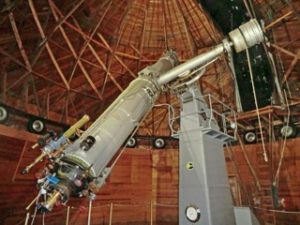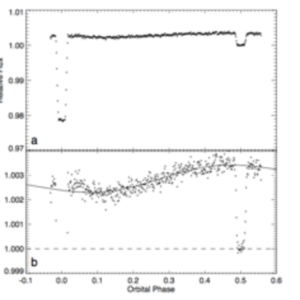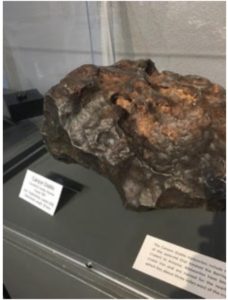 This week of my internship has been fantastic! Though most of my time was spent in front of a computer screen, I still managed to learn a lot about Lowell and all of the other research going on here.
This week of my internship has been fantastic! Though most of my time was spent in front of a computer screen, I still managed to learn a lot about Lowell and all of the other research going on here.
Thursday is unofficially my favorite day of the week now. Every other Thursday morning, Lowell hosts a “science tea” where all of the science staff at the observatory sit around with coffee, tea, and bagels to learn about each other’s new research developments and advances in the broader scientific community.
There is a student lunch that occurs in one of the conference rooms as well, which offers a great opportunity to learn about the research that other Lowell interns are doing.
It was very interesting to listen to what everyone else was working on, though to be honest it was also difficult. One undergrad was doing research on a binary star system and was preparing to write a paper about it. The system is very unique because unconventional variations in some data seem to point towards the possibility of it being a triple star system. I understood that much, but then one of the staff members began asking questions and suddenly almost all of the vocabulary and discussion flew right over my head. It sounded very scientific and exciting, but I have no idea what any of it meant. This upcoming week I plan on carrying around a notebook so that I can remember stuff to look up later.
Some afternoons a visiting astronomer/scientist visits Lowell and gives a talk to the staff, astronomers, and interns on the research they are doing. This last Thursday Daniel Angerhausen gave a talk on exoplanets. It was incredibly interesting and I learned so much about the information that can be gained from spectroscopic data of these distant solar systems.
The first exoplanet was actually found in 1988, and the fact that we are able to find these  little planets at all shows how advanced our technology has become. By analyzing the light curve of a star such as HD189733b (the one Mr. Angerhausen discussed), you can see distinct drops in the amount of light that we are receiving from the star. The large drop indicates the primary transit of the exoplanet across the star (it is, from our point of view, blocking some of the light coming towards us from the star). The second drop indicates the secondary transit, meaning that as the planet goes behind the star, and the star blocks the photons emitting from the planet, the total light of the system diminishes.
little planets at all shows how advanced our technology has become. By analyzing the light curve of a star such as HD189733b (the one Mr. Angerhausen discussed), you can see distinct drops in the amount of light that we are receiving from the star. The large drop indicates the primary transit of the exoplanet across the star (it is, from our point of view, blocking some of the light coming towards us from the star). The second drop indicates the secondary transit, meaning that as the planet goes behind the star, and the star blocks the photons emitting from the planet, the total light of the system diminishes.
One of the really cool features of this scenario is that, as seen in the bottom half of the graph picture, when you zoom into the stable section of the first graph, you are able to see that the light from the system actually varies in a sinusoidal shape. Similar to the phases of the moon, as the exoplanet travels around its star we see varying amounts of the day-side half of the planet, and therefore varying amounts of light from the system.
By analyzing the moment right before the planet goes into its secondary transit (meaning the moment when its day-side is facing the Earth, but before it goes behind the star), you can figure out a strong estimate of the temperature on that planet. The same can be done during the primary eclipse for the night side of the planet, which is the side facing us at that time. This science completely fascinated me because of how much information could be gained from one set of spectroscopic data, if you know where and how to look at it.
My work for Nick this week went smoothly. I had some computer troubleshooting to do — in other words, wait for 30 minutes for everything to load and the computer to stop freaking out, and then give up and try turning it off and back on — and spent a couple hours on Youtube trying to learn how to program. In the end, I finished putting all 629 asteroids into the new MANOS program (yay!), and have begun adding specific data on those asteroids to a table which can be automatically uploaded. Then I created files for every asteroid so that we can organize the results from the research.
I was very happy with all of the work that I accomplished this week because Nick was gone and I had to do a lot independently. This helped me become more comfortable with recognizing when I needed help and utilizing the resources around me to figure things out.
This past week I have been running almost everyday on the Flagstaff Urban Trail, which is a wide, dirt-packed trail that runs through Flagstaff, and comes right by my aunt and uncle’s house. It has been a great spot to run and is a common running and biking spot. I also bike to and from Lowell for work, which takes about 25 minutes each way. It has been very nice, although I was caught in one big storm coming home and showed up completely soaked.
I am very excited for next week because I will be moving up into the Mars Hill Lodge, which is housing on the Lowell campus for students who are working there. I will be living with some of the interns that I share work space with and will be available to participate in more of the evening programs at the observatory. I will also begin volunteering more with the Public Outreach Program next week, hosting open houses in some of the museums and telescope domes!
Here is a talk that Mr. Angerhausen gave that is almost identical to the one he gave at Lowell. (WARNING: the video is about an hour long, but super cool if you have the time)!
One thing that may help with understanding some of the information: Trojan asteroids are  asteroids that are trapped in stable gravity wells, called Lagrange points, which precede and/or follow a planet. Earth has Trojan asteroids, and so does Jupiter, Mars, and Neptune. Jupiter’s Trojan asteroid population is the largest, and is thought to include as many asteroids as reside in the Main Belt.
asteroids that are trapped in stable gravity wells, called Lagrange points, which precede and/or follow a planet. Earth has Trojan asteroids, and so does Jupiter, Mars, and Neptune. Jupiter’s Trojan asteroid population is the largest, and is thought to include as many asteroids as reside in the Main Belt.
Exoplanets with Jupiter trojans have large enough trojan asteroid populations (comparable to Jupiter’s) to cause additional drops in light curve readings. Often these drops cannot be detected in the spectroscopic readings of one exoplanet, but show up in a significant way when the light curve data of many exoplanets are layered.

There are no comments published yet.